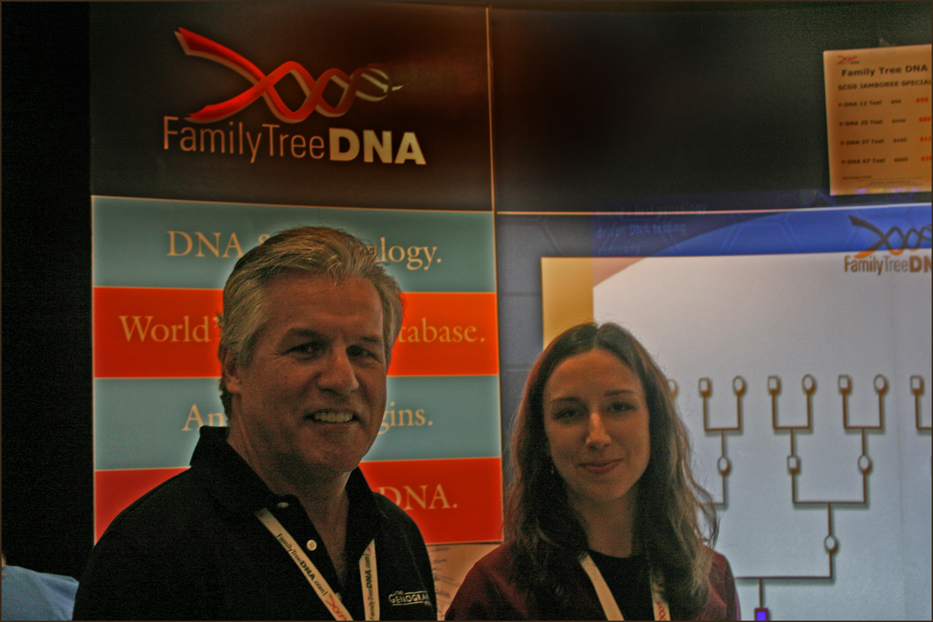As I mentioned in the two previous posts, I’ve begun DNA studies on my Danko and Niedzialkowski lines. Not all the results are in yet, but the results so far have provided good start on understanding my genetic ancestry. At the Southern California Genealogy Jamboree, I was able to meet with two of the folks from Family Tree DNA (the company who is conducting the tests on my family) who were kind enough to help explain the results obtained so far.
Max Blankfeld and Associate from Family Tree DNA
SOURCE: Max Blankfeld and Associate from Family Tree DNA (Burbank, Los Angeles Co., California). Photographed by Stephen J. Danko on 29 Jun 2008.
Because of the way DNA is inherited, the mitochondrial DNA (mtDNA) tests provide information on a strictly maternal line (my mother’s mother’s mother’s mother …) and the Y-Chromosomal (Y-DNA) tests provide information on a strictly paternal line (my father’s father’s father’s father …). For this reason, each of these tests provides information on only a small portion of my genetic makeup.
On my own DNA, I have had three tests performed:
- A 67 marker Y-DNA test for short tandem repeats (SNPs)
- A Y-DNA single nucleotide polymorphism test (SNP)
- A mtDNA test that sequenced my entire mitochondrial genome
Three of my Niedzialkowski/Niedzialkoski cousins also had a 67 marker Y-DNA test.
My father recently sent in a DNA sample for a mtDNA test that will sequence his entire mitochondrial genome.
The results indicate that:
- based on the STR analysis of my Y-DNA, my strictly paternal line belongs to haplogroup R1b;
- based on the SNP analysis of my Y-DNA, my strictly paternal line haplogroup can be refined to R1b1b2g, otherwise known as R1b-U106;
- based on the STR analysis of my Niedzialkowski cousins’ Y-DNA, my mother’s paternal line belongs to haplogroup R1a; and
- based on the sequence of my mtDNA, my strictly maternal line belongs to haplogroup W.
When my father’s mtDNA analysis is complete, I will also know the haplogroup to which my father’s maternal line belongs.
Thus, when my father’s results are in, I will have genetic information on my ancestry from all four of my grandparents. I know of relatives who can provide mtDNA from my father’s father’s mother’s line, and I hope one of those relatives will be willing to participate in this study.
Using the Sosa-Stradonitz Method for numbering ancestors, I have highlighted in bold those ancestors whose mtDNA (women) or Y-DNA (men) will be covered by the tests I’ve already conducted, and I have highlighted in italics those ancestors whose genetic signatures will be covered by the tests in progress or which I hope to conduct:
- Subject
- Father
- Mother
- Father’s father
- Father’s mother
- Mother’s father
- Mother’s mother
- Father’s father’s father
- Father’s father’s mother
- Father’s mother’s father
- Father’s mother’s mother
- Mother’s father’s father
- Mother’s father’s mother
- Mother’s mother’s father
- Mother’s mother’s mother
So, what’s the point of all this? Through these DNA studies, I hope to provide genetic evidence for the information I obtain through traditional genealogical methods, I hope to confirm or disprove some tenuous linkages, and I hope to find missing cousins.
In a larger context, I hope to discover if the various Niedzialkowski families come from the same genetic stock, and I also hope to learn if any of the many Danko families in Poland, Slovakia, the Czech Republic, Ukraine, and Hungary have a common genetic ancestry.
Wish me luck!
Copyright © 2008 by Stephen J. Danko




